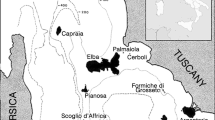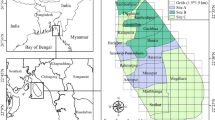Abstract
The Iberian Peninsula is recognized for its high levels of species richness, rarity and endemicity. Our main aim was to study biogeographic patterns of spiders in coastal dunes along a gradient of mediterraneity. Distance-decay of similarity, nestedness and co-occurrence metrics were used to explore spider’ distribution patterns. A similarity analysis was performed in order to obtain a hierarchical classification of sites. Indicator species analysis was conducted to identify indicator species for the various clustering levels of the site typology. The differentiation among assemblages was further explored by non-metric multidimensional scaling (NMDS) and analysis of similarities (ANOSIM). Assemblages’ similarity among sites decreased with climatic/geographic distance. The observed values of nestedness metrics (T and NODF) were not significant, while the co-occurrence metrics (C-score and Checkerboard units) were higher than expected by chance. Cluster analysis showed that spider’ assemblages were structured along a gradient from North to South, forming four geographically distinct clusters. ANOSIM tests and NMDS supported the biogeographic patterns identified by cluster analysis. Several indicator species were found for the different levels of the hierarchic site typology. Spider assemblages revealed a high degree of biogeographical structure along the Atlantic coast of the Iberian Peninsula. The coast is a “biogeographic crossroad”, encompassing faunistic elements of different origins. The hierarchic typology of sites is generally consistent with the major biogeographic regions and the thermoclimatic belts recognized for the region. Our results indicate that the climatic gradient and historic factors played a key role in the current spiders’ biogeographic patterns.






Similar content being viewed by others
References
Almeida-Neto M, Guimarães PR, Lewinsohn TM (2007) On nestedness analyses: rethinking matrix temperature and anti-nestedness. Oikos 116:716–722
Blondel J, Aronson J, Bodiou J-Y, Boeuf G (2010) The Mediterranean region: biological diversity in space and time. Oxford University Press, Oxford
Bonte D, Maes D (2008) Trampling affects the distribution of specialised coastal dune arthropods. Basic Appl Ecol 9:726–734
Bonte D, Lens L, Maelfait J-P, Hoffmann M, Kuijken E (2003a) Patch quality and connectivity influence spatial dynamics in a dune wolfspider. Oecologia 135:227–233
Bonte D, Criel P, Van Thournout I, Maelfait J-P (2003b) Regional and local variation of spider assemblages (Araneae) from coastal grey dunes along the North Sea. J Biogeogr 30:901–911
Bonte D, Baert L, Lens L, Maelfait J-P (2004) Effects of aerial dispersal, habitat specialisation, and landscape structure on spider distribution across fragmented grey dunes. Ecography 27:343–349
Cabrero-Sañudo FJ, Lobo JM (2006) Determinant variables of Iberian Peninsula Aphodiinae diversity (Coleoptera, Scarabaeoidea, Aphodiidae). J Biogeogr 33:1021–1043
Cardoso P (2009) Standardization and optimization of arthropod inventories-the case of Iberian spiders. Biodivers Conserv 18:3949–3962
Cardoso P, Moreno E (2010) The Iberian spider checklist (Araneae). Zootaxa 2495:1–52
Cardoso P, Silva I, de Oliveira NG, Serrano ARM (2007) Seasonality of spiders (Araneae) in Mediterranean ecosystems and its implications in the optimum sampling period. Ecol Entomol 32:516–526
Cardoso P, Gaspar C, Pereira LC, Silva I, Henriques SS, Silva RR, Sousa P (2008a) Assessing spider species richness and composition in Mediterranean cork oak forests. Acta Oecol 33:114–127
Cardoso P, Scharff N, Gaspar C, Henriques SS, Carvalho R, Castro PH, Schmidt JB, Silva I, Szüts T, Castro A, Crespo LC (2008b) Rapid biodiversity assessment of spiders (Araneae) using semi-quantitative sampling: a case study in a Mediterranean forest. Insect Conserv Divers 1:71–84
Cardoso P, Aranda SC, Lobo JM, Dinis F, Gaspar C, Borges PAV (2009a) A spatial scale assessment of habitat effects on arthropod communities of an oceanic island. Acta Oecol 35:590–597
Cardoso P, Borges PAV, Veech JA (2009b) Testing the performance of beta diversity measures based on incidence data: the robustness to undersampling. Divers Distrib 15:1081–1090
Cardoso P, Arnedo MA, Triantis KA, Borges PAV (2010) Drivers of diversity in Macaronesian spiders and the role of species extinctions. J Biogeogr 37:1034–1046
Clarke KR, Warwick RM (1994) Change in marine communities: an approach to statistical analysis and interpretation. Plymouth Marine Laboratory, Plymouth
Colwell RK (2009) EstimateS: statistical estimation of species richness and shared species from samples. Version 8.2. http://viceroy.eeb.uconn.edu/estimates. Persistent URL http://purl.oclc.org/estimates. Accessed 1 July 2010
Comor V, Orgeas J, Ponel P, Rolando C, Delettre YR (2008) Impact of anthropogenic disturbances on beetle communities of French Mediterranean coastal dunes. Biodivers Conserv 17:1837–1852
Costa JC, Aguiar C, Capelo JH, Lousã M, Neto C (1998) Biogeografia de Portugal Continental. Quercetea 0:5–56
Dufrêne M, Legendre P (1997) Species assemblages and indicator species definition: the need of an asymmetrical and flexible approach. Ecol Monogr 67:345–366
Entling W, Schmidt MH, Bacher S, Brandl R, Nentwig W (2007) Niche properties of Central European spiders: shading, moisture, and the evolution of the habitat niche. Glob Ecol Biogeogr 16:440–448
Filipe AF, Araújo MB, Doadrio I, Angermeier PL, Collares-Pereira MJ (2009) Biogeography of Iberian freshwater fishes revisited: the roles of historical versus contemporary constraints. J Biogeogr 36:2096–2110
Finch O-D, Blick T, Schuldt A (2008) Macroecological patterns of spider species richness across Europe. Biodivers Conserv 17:2849–2868
Garcia-Barros E, Gurrea P, Luciáñez MJ, Cano JM, Munguira ML, Moreno JC, Sainz H, Sanz MJ, Simón JC (2002) Parsimony analysis of endemicity and its application to animal and plant geographical distributions in the Ibero-Balearic region (western Mediterranean). J Biogeogr 29:109–124
Gómez A, Lunt DH (2007) Refugia within refugia: patterns of phylogeographic concordance in the Iberian Peninsula. In: Weiss S, Ferrand N (eds) Phylogeography of Southern European Refugia. Springer, Dordrecht, pp 155–188
González JA, Gayubo SF, Asís JD, Tormos J (2009) Diversity and biogeographical significance of solitary wasps (Chrysididae, Eumeninae, and Spheciformes) at the Arribes del Duero Natural Park, Spain: their importance for insect diversity conservation in the Mediterranean region. Environ Entomol 38:608–626
Gotelli NJ, McCabe D (2002) Species co-occurrence: a meta-analysis of J. M. Diamond’s assembly rules model. Ecol 83:2091–2096
Helsdingen PJ (2009) Araneae. In: Fauna Europaea Database (Version 2009.2). http://www.european-arachnology.org. Accessed 1 July 2010
Heslenfeld P, Jungerius PD, Kijn JA (2004) European coastal dunes: ecological values, threats, opportunities and policy development. In: Martínez ML, Psuty N (eds) Coastal dunes: ecology and conservation. Springer-Verlag, Heidelberg, pp 335–351
Jiménez-Moreno G, Fauquette S, Suc J-P (2010) Miocene to Pliocene vegetation reconstruction and climate estimates in the Iberian Peninsula from pollen data. Rev Palaeobot Palynol 163:403–415
Jiménez-Valverde A, Lobo JM (2007) Determinants of local spider (Araneidae and Thomisidae) species richness on a regional scale: climate and altitude vs. habitat structure. Ecol Entomol 32:113–122
Kaufman L, Rousseeuw PJ (1990) Finding groups in data: an introduction to cluster analysis. John Wiley and Sons, Inc., Hoboken
Kelley LA, Gardner SP, Sutcliffe MJ (1996) An automated approach for clustering an ensemble of NMR-derived protein structures into conformationally-related subfamilies. Protein Eng 9:1063–1065
Legendre P, Legendre L (1998) Numerical ecology. Elsevier, Amsterdam
Lomba A, Alves P, Honrado J (2008) Endemic sand dune vegetation of the Northwest Iberian Peninsula: diversity, dynamics, and significance for bioindication and monitoring of coastal landscapes. J Coast Res 24:113–121
Longino JT, Coddington J, Colwell RK (2002) The ant fauna of a tropical rain forest: estimating species richness three different ways. Ecology 83:689–702
Maechler M (2010) cluster: cluster analysis extended. In: Rousseeuw et al. R package version 1.13-1. http://cran.r-project.org. Accessed 1 July 2010
Maltez-Mouro S, Maestre FT, Freitas H (2010) Co-occurrence patterns and abiotic stress in sand-dune communities: their relationship varies with spatial scale and the stress estimator. Acta Oecol 36:80–84
Marc P, Canard A, Ysnel F (1999) Spiders (Araneae) useful for pest limitation and bioindication. Agric Ecosyst Environ 74:229–273
Martín J, Gurrea P (1990) The peninsular effect in Iberian butterflies (Lepidoptera, Papilionoidea and Hesperioidea). J Biogeogr 17:85–96
Meulen F, Salman AHPM (1996) Management of Mediterranean coastal dunes. Ocean Coast Manag 30:177–195
Myers N, Mittermeier RA, Mittermeier CG, Fonseca GAB, Kent J (2000) Biodiversity hotspots for conservation priorities. Nature 403:853–858
Nekola JC, White PS (1999) Distance decay of similarity in biogeography and ecology. J Biogeogr 26:867–878
Oksanen J, Blanchet FG, Kindt R, Legendre P, O’Hara RB, Simpson GL, Solymos P, Stevens MHH, Wagner H (2010) vegan: community ecology package. R package version 1.17-3. http://cran.r-project.org. Accessed 1 July 2010
Platnick NI (2010) The world spider catalog, version 11.0. American Museum of Natural History. http://research.amnh.org/entomology/spiders/catalog/index.html. Accessed 1 July 2010
R Development Core Team (2009) R: a language and environment for statistical computing. R Foundation for Statistical Computing, Vienna, Austria. ISBN 3-900051-07-0. http://www.r-project.org. Accessed 1 July 2010
Rivas-Martínez S, Penas A, Díaz TE (2004a) Biogeographic map of Europe. Cartographic Service. University of León, Leon
Rivas-Martínez S, Penas A, Díaz TE (2004b) Bioclimatic map of Europe, thermoclimatic belts. Cartographic Service. University of León, Spain
Roberts DW (2010) labdsv: ordination and multivariate analysis for ecology. R package version 1.4-1. http://cran.r-project.org. Accessed 1 July 2010
Rodríguez-Gironés MA, Santamaría L (2006) A new algorithm to calculate the nestedness temperature of presence-absence matrices. J Biogeogr 33:924–935
Romo H, García-Barros E (2010) Biogeographic regions of the Iberian Peninsula: butterflies as biogeographical indicators. J Zool 282:180–190
Scharff N, Coddington JA, Griswold CE, Hormiga G, Bjørn PP (2003) When to quit? Estimating spider species richness in a Northern European deciduous forest. J Arachnol 31:246–273
Simpson GG (1964) Species density of North American recent mammals. Syst Zool 12:57–73
Stefanescu C, Herrando S, Páramo F (2004) Butterfly species richness in the north-west Mediterranean Basin: the role of natural and human-induced factors. J Biogeogr 31:905–915
Stone L, Roberts A (1990) The checkerboard score and species distributions. Oecologia 85:74–79
Tellería JL, Santos T (1993) Distributional pattern of insectivorous passerines in the Iberian forests: does abundance decrease near the border? J Biogeogr 20:235–240
Ulrich W, Almeida-Neto M, Gotelli NJ (2009) A consumer’s guide to nestedness analysis. Oikos 118:3–17
White D (2009) maptree: mapping, pruning, and graphing tree models. R package version 1.4-6. http://cran.r-project.org. Accessed 1 July 2010
Whittaker RJ, Araújo MA, Jepson P, Ladle RJ, Watson JEM, Willis KJ (2005) Conservation biogeography: assessment and prospect. Divers Distrib 11:3–23
Willig MR, Kauffman DM, Stevens RD (2003) Latitudinal gradients of biodiversity, pattern, process, scale and synthesis. Ann Rev Ecol Syst 34:273–309
Wise DH (1993) Spiders in ecological webs. Cambridge University Press, New York
Acknowledgments
We are acknowledged to José António Barrientos, Carmen Urones and Stano Pékar for their help with the taxonomic identification of some spider specimens and to Robert Bosmans and Hisham El-Hennawy for their contribution to identify Mediterranean species that occur in Northern Africa. J.C.C. express his gratitude to the Luso-American Foundation for its support (FLAD CandT Links 2010 grant). P.C. is supported by Fundação para a Ciência e Tecnologia (SFRH/BPD/40688/2007).
Author information
Authors and Affiliations
Corresponding author
Appendices
Appendix 1
See Table 3.
Appendix 2
See Table 4.
Rights and permissions
About this article
Cite this article
Carvalho, J.C., Cardoso, P., Crespo, L.C. et al. Biogeographic patterns of spiders in coastal dunes along a gradient of mediterraneity. Biodivers Conserv 20, 873–894 (2011). https://doi.org/10.1007/s10531-011-0001-8
Received:
Accepted:
Published:
Issue Date:
DOI: https://doi.org/10.1007/s10531-011-0001-8




